(Editor’s note: This article by Jeff Neilson, Diany Faila Sophia Hartatri, and Mark Vicol originally appeared in the January/February 2019 issue of Roast Magazine. Links have been added for context.)
The global specialty coffee sector has grown rapidly in recent years amid the increasing demand for high-quality coffee. In Indonesia, coffee has long been a smallholder crop, typically grown by (often poor) family farmers before being traded as a commodity through a complex and long value chain to roasting and consumption. The trend in many specialty coffee value chains over the past decade, however, is toward closer relationships between specialty roasting firms and coffee farmers, with a focus on producing high-quality and traceable coffee.
Research funded by the Australian Centre for International Agricultural Research from 2008 to 2018, and implemented by researchers from the University of Sydney in Australia and the Indonesian Coffee and Cocoa Research Institute, has sought to understand the potential livelihood benefits for Indonesian farmers who participate in what we call “relationship coffees.” The research involved six case studies across North Sumatra, West Java, Bali, Flores and Sulawesi (two sites), where farmers have engaged in relationship coffees, sometimes through action research interventions supported by the research team.

Small coffee plots around traditional hamlets in the Toraja highlands of Sulawesi, where coffee is part of diversified rural livelihoods. Photo by Jeff Neilson.
While there is no widely accepted definition for “relationship coffee,” for the purpose of this research we understand it to be coffee marketed to consumers as being procured through a relationship between the roaster and producer that typically involves personal interaction, mutual trust, price transparency, a commitment to quality improvement, and a stated intention to improve the lives of coffee farmers and their communities. Roasters often are eager to demonstrate their superior knowledge about origin, and their close relationships with origin communities are presented as a point of distinction to consumers. The definition of “relationship,” however, is broader than “direct trade,” which seems to explicitly exclude a role for middlemen, logistics and traders.
The relationship coffees observed in our study typically involve international roasters (Australian firms are currently the main players in Indonesia), although the Indonesian domestic specialty market has grown dramatically during the past decade. When our research commenced, virtually all specialty coffee was exported from Indonesia, but now we see the increasing influence at the farm level of roasters and cafes from places like Jakarta, Bandung and Surabaya. It’s much easier to maintain relationships when you speak the same language, can visit regularly at minimal cost, and can trade easily in small volumes without the need to fill a container. Two of our case studies involved domestic roasters, whose general approach and presentation of their relationships to consumers is remarkably similar to the international roasters.
While such relationships appear to offer exciting opportunities for farmers, a survey of peer-reviewed literature found little independent assessment to date of the development impacts of relationship coffee in farming communities. Just what kinds of relationships or value chain structures lead to what outcomes for farmers remains under-researched, and the claims made by specialty roasters about the benefits of relationship coffee are largely unverifiable. Our research — conducted over the past 10 years in Indonesia, and recently published in the journal World Development — suggests that the development outcomes of relationship coffee interventions can often be disappointing. Here, we identify some of the pitfalls, challenges and opportunities related to coffee farmer development. We do this by presenting nine myths commonly believed by development actors about coffee development in Indonesia that we believe need to be re-assessed. While these myths have been drawn from the Indonesian experience, we believe they are likely to have strong resonance elsewhere.
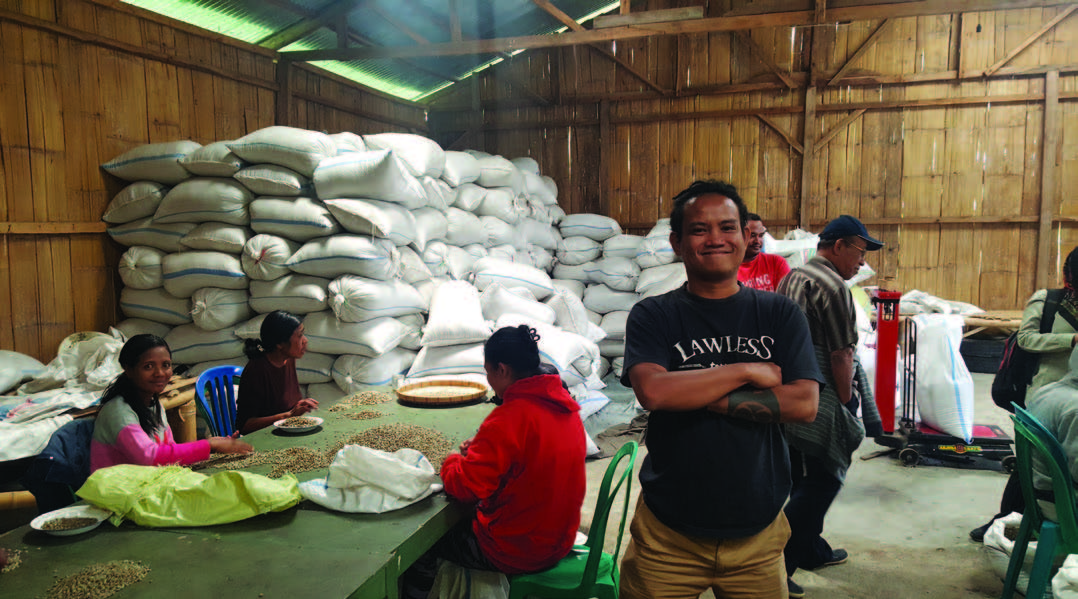
Part of a new breed of Indonesian specialty coffee buyers, Derby Sumule works directly with farmers, such as these coffee growers on Flores Island, to supply high-quality coffee to Indonesia’s urban centers. Photo by Jeff Neilson.
Value Chain Interventions and Rural Development
Relationship coffee reflects a broader trend in rural development practice known as value chain development (VCD). The VCD approach holds that an effective way to improve the lives of impoverished farmers is to connect them to modern markets through global value chains (GVCs). GVCs can be thought of as the chain of actors (farmers, collectors, cooperatives, processors, traders, roasters and retailers, in the case of coffee) who add value to the raw material as it moves through the chain, and whose actions often are coordinated by a lead firm (roasters in the coffee sector). GVC theory suggests that the value chains that connect far flung sites of production and consumption constitute a defining feature of the global economy, and there has been a rapid uptake of value chain thinking within development agencies, nongovernmental organizations (NGOs) and governments over the past decade.
Development interventions aim to link small farmers to value chains, typically by supporting closer relationships with downstream buyers such as roasters. The idea is that facilitating such relationships will put farmers on dynamic learning curves, where buyers will assist farmers in acquiring new skills and competencies, allowing them to improve their position in the value chain. In Indonesia, we find examples of roasters providing training (either directly or indirectly) to farmers in quality control, good agricultural practices, finance and environmental management. This can result in higher incomes and broader development benefits. In specialty coffee value chains, this may include farmers improving quality, improving efficiency of production and marketing, or moving into the processing of parchment coffee to green beans.
Coffee Interventions in Indonesia
Historically, Indonesian smallholders have marketed their coffee through traditional trade networks that involve maintaining relationships with village collectors. Farmers growing arabica coffee traditionally use an on-farm processing method to pulp, ferment, wash and partially dry parchment coffee before selling to a collector. The semi-wet parchment coffee then moves through centralized processing mills before the green beans are either exported or sold to domestic roasters.
This traditional value chain structure has been criticized as inefficient and exploitative of small farmers, whose share of the final value of coffee sold to consumers is said to be reduced by the many “middlemen” the coffee passes through. The arms-length relationship between roasting firms and farmers is similarly bad for specialty roasters, who are unable to influence quality control procedures and improve production practices at the farm. Indonesia has a reputation for producing some excellent, top-of-the range specialty coffees, although consistency can be a serious problem.
Relationship coffees often are set up through the direct intervention of roasters. In Indonesia, the government and development NGOs also have supported buyer engagement with coffee farmers through initiatives to upgrade the competencies of farmers. This has included establishing farmer-managed processing units (known as Unit Pengolahan Hasil), where producers are supplied with processing equipment (and often encouraged to dry-hull the parchment coffee), and quality management training. Five of the six roaster relationships we observed were built upon such government-support programs.
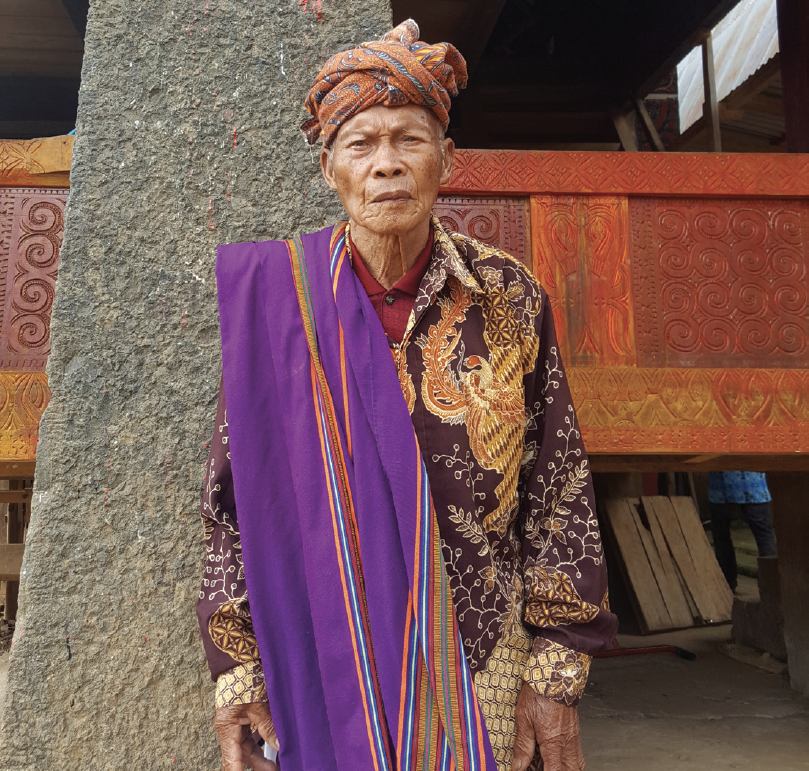
An elderly villager in Toraja who recalls Dutch policies toward coffee prior to World War II. The importance of coffee for local livelihoods has ebbed and flowed ever since. Photo by Jeff Neilson.
Nine Myths About Coffee Farmer Development
It is common for roasters to populate their websites with blog posts about journeys to origin, accompanied by photos and anecdotes about the relationships formed with individual farmers and the developmental benefits of these relationships. The claims about the positive development impacts of relationship coffee appear to be based on a series of assumptions about coffee-growing households and communities. From our experience in Indonesia, we have identified nine such assumptions — or myths — that we believe warrant further research if coffee development is to meet the expectations of both farmers and roasters.
Clearly, these myths are not universally believed by all coffee roasters engaging in farmer relationships or by all development agencies acting in this space. However, we believe they are stated or implied frequently enough by various stakeholders to warrant further scrutiny. These assumptions have been drawn from various sources, including: directly from roasters or their websites; at various development forums and seminars in Indonesia; from written government policies and programs; and from formal theories of change prepared by development agencies working with coffee farmer development and sustainability programs.
1. Increasing coffee incomes will improve the livelihoods of coffee-growing households. While there are thought to be up to 2 million households that grow coffee as part of their livelihood across Indonesia, there are actually very few that only grow coffee. For some of these households, coffee will be the most important source of cash income; for others, it will be far less important than food crop production, other cash crops or non-farm incomes. Coffee incomes can be increased by either increasing production or by increasing prices. To do so usually requires additional resources (capital, land and/or labor), so this increased income will not improve livelihoods if there are high opportunity costs or trade-offs. Sometimes, the household would be better off investing in their children’s education in the hope of future urban employment, or by spending their time working as ojek (motorcycle taxi) drivers or opening a warung (small restaurant). In areas such as North Sumatra, coffee is viewed by farmers as a backup crop that can supply a regular source of income but is unlikely to make a household wealthier.
2. Producing higher-quality coffee will result in higher incomes for farmers. This is not always the case, as quality improvement also can involve increased costs and risks for producers. This includes the additional labor costs of selectively picking only red cherries, regular pulping of smaller volumes rather than pooling cherries weekly, manually removing damaged beans, and careful drying and storage. These additional costs often exceed any price premium for quality. Our research in Sulawesi has shown that, even where farmer organizations receive higher prices for quality coffee, this value often is lost within the farmer organization by organizational inefficiencies, mismanagement, or by processing facilities being captured and controlled by local elites. Quality improvement frequently increases risk exposure, as farmers will incur increased costs in the hope that quality and prices also increase, but adverse weather or other unexpected events may negatively affect quality such that the premium disappears while farmers are forced to bear their increased production costs. A quality improvement strategy is not always in the interest of coffee farmers.
3. Cutting out the middleman will result in higher prices for farmers. The pejorative Indonesian term for exploitative middlemen is tengkulak, while references to coyotes abound in Latin America. This myth, however, will not hold true if the middleman is the most efficient provider of logistical, quality control and financial services, which they often are. These services will still need to be undertaken by either the farmer, a farmer cooperative, or the downstream buyer (exporter or roaster). In cases where this function is replaced by a farmer cooperative (as in Sulawesi and Flores), the cooperative may be inefficient or even corrupt, which means their costs will be high. Similarly, a downstream buyer (such as a retailer or roaster) will have high costs for transport, travel and quality control. These higher transaction costs ultimately will exert a downward pressure on farm-gate prices. Further, middlemen often perform other important functions such as credit provision and provision of basic needs that farmers may find difficult to access elsewhere. Relationships between farmers and traditional collectors in Indonesia can be deeply entwined in local kinship ties through family and patronage, and the breakdown of these relationships may result in the rupturing of social capital and the loss of livelihood for the collector. In Indonesia, “cutting out the middleman” has, in some instances, actually resulted in lower farm-gate prices.
4. Processing coffee further at the farm level will add value. Generally, arabica coffee processing involves pulping, fermentation, washing, drying, hulling, grading, cleaning, roasting, grinding and beverage preparation. While it is technically feasible for all these steps to be undertaken at the farm level, this is not always in the best interest of the farmer for two reasons. First, these activities all have costs and take time, and these costs often exceed any added value created when undertaken at small scale. Second, higher consumer prices are obtained for higher-quality coffee, and allowing specialists to undertake processing often will add more value. For example, we find in Sulawesi that farmers selling fresh cherries or wet parchment to a centralized mill with good quality control procedures (and a higher final price) receive higher per-unit prices than farmers who attempt to hull or roast their own coffee, but whose quality control systems are less well developed. Further processing at the farm level often will mean that coffee is being stored for longer periods, such that the inherent risks associated with price fluctuations or quality deterioration are borne by farmers.
5. The main problem faced by coffee farmers is limited capital. While farmers may not have access to formal finance from the banking sector, it is often the case that farmers will not voluntarily invest in coffee production and processing even when they do have access to finance. Many government support programs in Indonesia provide farmer organizations with capital in an attempt to enable them to increase productivity, engage in downstream activities such as the provision of processing equipment, or finance trading activities. However, poor competitiveness in these supply chain activities frequently results in failure, and the numerous abandoned processing units across producing regions is testament to this. In Bali, Flores and Sulawesi, coffee producer organizations also have been provided with upfront capital directly from roasters, but with insufficient capacity to monitor activities, this finance has been allocated to other, non-coffee-related needs. Rural households rarely farm as a business in Indonesia, so integration into financial markets and indebtedness may be counterproductive. Instead, coffee frequently offers a resilient livelihood option for households in Indonesia where risk aversion is paramount.
6. Coffee grown in a particular region possesses a superior taste. Certain regions have strong reputations for high-quality coffee (for example, Toraja or Gayo in Indonesia). It is often assumed that this is a result of physical geography (altitude, soil, tree cover, etc.) and local cultural practices, such that all coffee grown in that region is sometimes assumed to have the same quality attributes. The myth is significantly shaped by the ubiquitous place-based marketing adopted by many roasters (international and domestic), as it is used to sell different coffee origins, even while roasters themselves are more cautious in their assessment of geography’s role in quality. This has triggered strong interest in geographical indications across the coffee world, including in Indonesia. This myth is widely held by many government policy-makers with a limited understanding of coffee processing and quality. It is only partially true at best. Quality is created through a combination of physical geography with post-harvest processing systems, whereby the latter is a dominant factor. Poor-quality coffee is also produced in regions with otherwise excellent reputations, and quality deterioration can occur at any point along the processing chain if poorly managed. Development initiatives that neglect quality control mechanisms and rely solely on geography will not maintain strong market demand.
7. Farmer cooperatives are the best way to organize producers. Formal cooperatives were involved in four of our case studies, with cooperative-like producer organizations found in the other two. One aim of a cooperative is to improve the “bargaining power” of farmers, but coffee prices generally are set internationally and determined by global processes of supply and demand. A local cooperative of farmers will increase bargaining power only if it operates as a farmers union and free-riding is effectively controlled, which seems unlikely. Globally, value chains are increasingly buyer-driven, and even in developed country contexts with strong cooperative traditions, farmer cooperatives have little bargaining power against retailers and other lead firms. Cooperatives will be successful only when they can provide services to both members and buyers more effectively than alternative value chain arrangements, and this is often not the case. Many buyers hope that cooperatives will provide economies of scale when dealing with scattered smallholders. In our experience, the ideal of a cooperative held by both roasters and development actors is often far from the reality in Indonesia, with the risk that a poorly adapted organizational structure is prioritized when other alternatives, such as local collector networks, may be better suited.
8. Relationship coffees result in higher quality. Cafe owners and roasters often expect that they will get better quality coffee by buying in a more direct way from farmers. However, these buyers are not always expert supply chain managers. Many specialty roasters are small businesses with limited turnover, which means they may not have the economies of scale that would allow recruitment of supply chain specialists. When a buyer lacks the skills or resources to enforce strict quality controls at farm-gate, it is rational for farmers to sell coffee at a quality level that minimally satisfies the quality control system of the buyer while minimizing their own cost and effort. As a result, the impact of numerous small buyers of coffee at the farm level across Indonesia over the past decade appears to have been increased competition that has raised prices (at least in the short term) but has led to a decline in quality that is likely to have longer-term impacts on industry prospects.
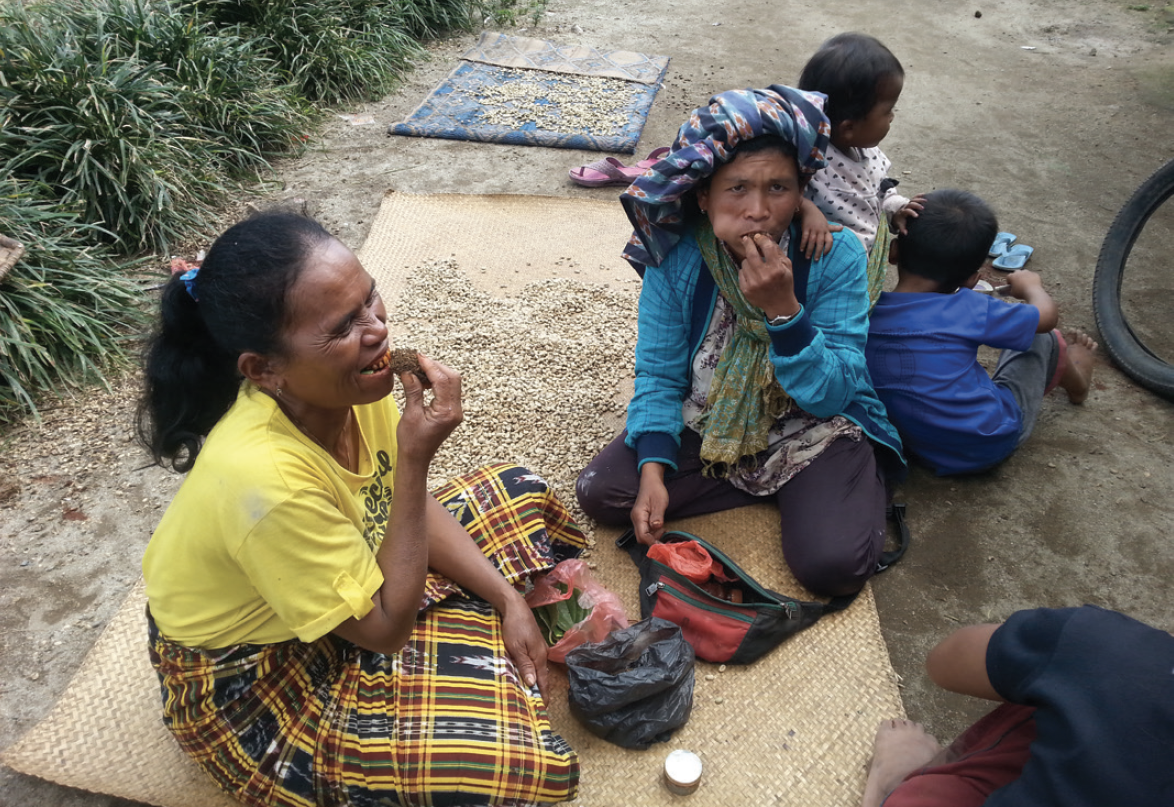
Two women in North Sumatra enjoying some betel nut. Indonesian women often are heavily involved in the traditional collection and village trade of coffee. However, they are generally less involved in formal cooperative structures. Photo by Diany Faila Sophia Hartatri.
9. Relationships between farmers and roasters are sustainable because of mutual interests. The long-term development impacts of relationship coffee depend on a substantial commitment from buyers and producers to maintain relationships over time. It is often the case, however, that market pressures and other unforeseen challenges such as production bottlenecks, reductions in quality and adverse weather events result in the breakdown of trade relationships. In several of our case studies in Indonesia, roasters pulled out of the relationships when their profitability was threatened. Roasters are not development agencies, and for all their good intentions, ultimately they are driven by the logic of ensuring sustainable profits in a competitive environment. In some cases, however, roasters have continued to display marketing material including blog posts and photos of farmers on their websites from relationship coffee interventions that are no longer functioning. Similarly, producers or individuals representing producers were observed using a buyer relationship to improve their own prestige and social capital without sharing the roaster’s same commitment. The most frequently observed cause of relationship collapse in our case studies was the inability to put in place effective risk-sharing and risk-management mechanisms. Relationships require long-term commitments and the nurturing of trust and social ties, which are difficult to maintain remotely.
Fostering Sustainable Relationships
Our research over the past 10 years in Indonesia paints a complicated portrait of relationship coffee and rural development. In some cases, individuals have benefitted from these interventions. These tend to be prominent village members, such as cooperative leaders, who can use their position of privilege to accrue economic gains in key quality control nodes in the value chain. For other farmers, relationship coffee interventions have resulted in the transfer of knowledge, skills and price certainty. However, the overall impact on farmer livelihoods and rural development often falls short of the claims made by roasters and development agencies.
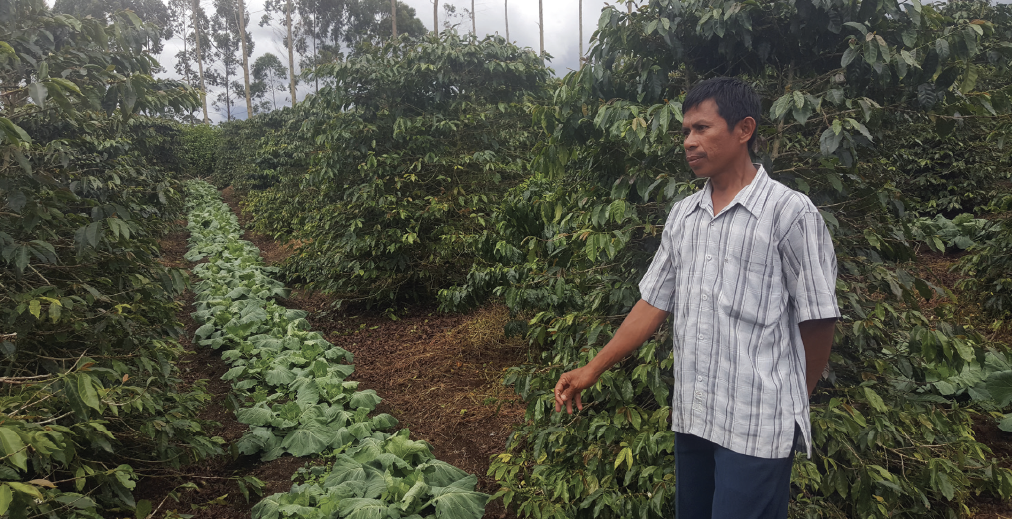
A coffee farmer in North Sumatra, where coffee is commonly intercropped with intensive vegetable production. Photo by Jeff Neilson.
What is the future for relationship coffees? Can this model offer a sustainable alternative to mainstream value chains, while improving the lives of small coffee farmers? If roasters are serious about rural development, our research suggests that it may be helpful to start questioning some of the common assumptions about coffee-growing communities, the livelihood priorities of producers, and the realistic benefits of value chain interventions.
A livelihood lens is often helpful in explaining why certain development interventions are successful and others fail. While proponents of coffee interventions typically have good intentions when it comes to rural development, the assumption that coffee represents the best pathway out of poverty does not always match local livelihood priorities. This does not necessarily mean that coffee is unimportant, but it may explain why household resources are not dedicated to increasing production or quality.
A key message running through many of the myths explored in this article is the need to address risk exposure and risk management effectively, and the need to develop institutional mechanisms where the risks inherent to quality upgrading are appropriately shared among value chain actors. A lack of this has been perhaps the most common cause of relationship failure.
—
JEFF NEILSON is a senior lecturer in geography at the University of Sydney and project leader for “Evaluating smallholder livelihoods and sustainability in Indonesian coffee and cocoa value chains,” a research activity funded by the Australian Centre for International Agricultural Research (ACIAR; 2014–2019). He has conducted research on the Indonesian coffee sector since 2001, with a particular interest in changing rural livelihoods.
DIANY FAILA SOPHIA HARTATRI is a senior social scientist at the Indonesian Coffee and Cocoa Research Institute, located in Jember, Indonesia, and lead social researcher on the ACIAR project. Her research examines rural development opportunities for Indonesian farmers resulting from market engagement.
MARK VICOL is a post-doctoral research associate in geography at the University of Sydney, who currently conducts research on agrarian change, food security and rural political economy in Indonesia, Myanmar and India.
Comment
1 Comment
Comments are closed.




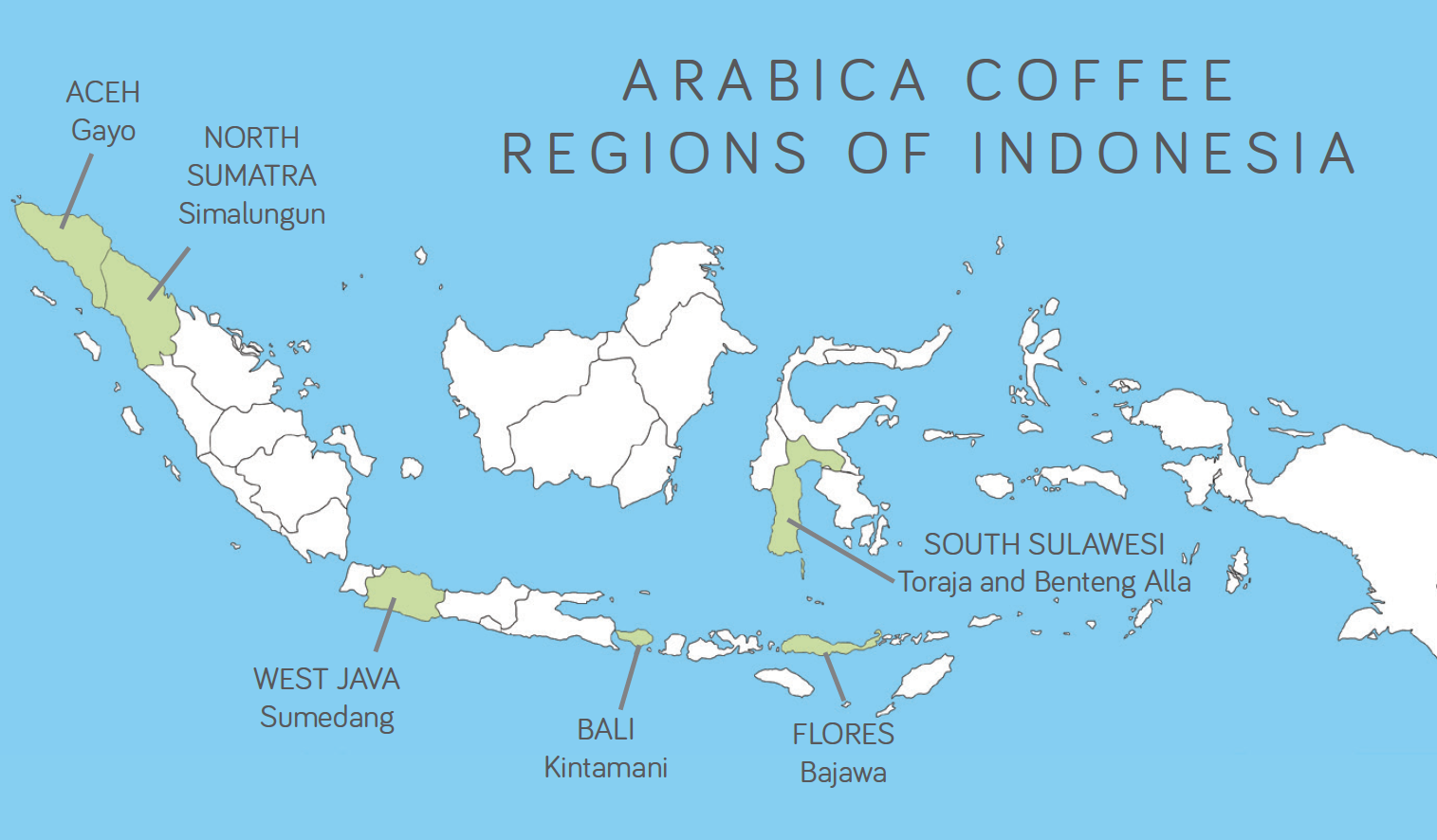
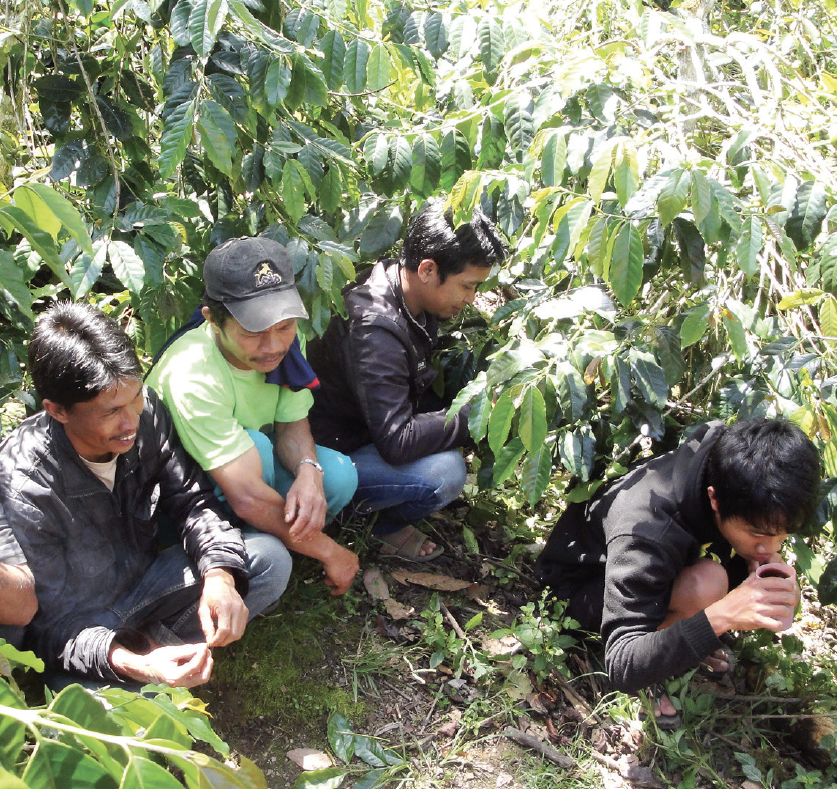

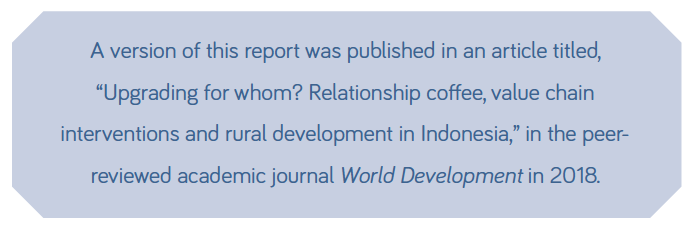



I do appreciate